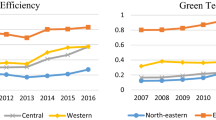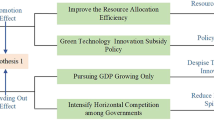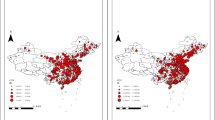Abstract
Green technological innovation has gained in importance in regional policy making towards gaining competitive advantage and sustainable development. This paper used the data envelopment analysis method to calculate regional green innovation efficiency in China, and empirically tested the effect of fiscal decentralization through Tobit model. The regression results show that the local governments with higher fiscal autonomy would prefer to strengthen environmental protection; thus, the regional green innovation efficiency was improved. After the guidance of relevant national development strategies, these effects became more apparent. Our research provided theoretical support and practical guidance for promoting regional led green innovation, improving environmental quality, achieving carbon neutrality, and promoting the high-quality and sustainable development.
Similar content being viewed by others
Data availability
The datasets supporting the results of this article are included within the article and its additional files.
References
Baron RM, Kenny DA (1986) The moderator-mediator variable distinction in social psychological research: conceptual, strategic and statistical considerations. J Pers Soc Psychol 51(6):1173–1182. https://doi.org/10.1037/0022-3514.51.6.1173
Beise M, Rennings K (2005) Lead markets and regulation: a framework for analyzing the international diffusion of environmental innovation. Ecol Econ 52(1):5–17. https://doi.org/10.1016/j.ecolecon.2004.06.007
Bi KX, Huang P, Wang XX (2016) Innovation performance and influencing factors of low-carbon technological innovation under the global value chain: a case of Chinese manufacturing industry. Technol Forecast Soc Chang 11:275–284. https://doi.org/10.1016/j.techfore.2016.07.024
Borge LE, Brueckner JK, Rattso J (2014) Partial fiscal decentralization and demand responsiveness of the local public sector: theory and evidence from Norway. J Urban Econ 80:153–163. https://doi.org/10.1016/j.jue.2014.01.003
De Medeiros JF, Ribeiro JLD, Cortimiglia MN (2014) Success factors for environmentally sustainable product innovation: a systematic literature review. J Clean Prod 65(15):76–86. https://doi.org/10.1016/j.jclepro.2013.08.035
Denise V, Lorentzen P, Mattingly D (2017) Racing to the bottom or to the top? Decentralization, revenue pressures, and governance reform in China. World Dev 95:164–176. https://doi.org/10.1016/j.worlddev.2017.02.021
Du JL, Liu Y, Diao WX (2019) Assessing regional differences in green innovation efficiency of industrial enterprises in China. Int J Environ Res Public Health 16(6):940. https://doi.org/10.3390/ijerph16060940
Filippetti A, Archibugi D (2011) Innovation in times of crisis: national systems of innovation, structure, and demand. Res Policy 40(2):179–192. https://doi.org/10.1016/j.respol.2010.09.001
Fried HO, Lovell CAK, Schmidt S (2002) Accounting for environmental effects and statistical noise in data envelopment analysis. J Prod Anal 17(1):157–174. https://doi.org/10.1023/A:1013548723393
Fussier C, James P (1996) Driving eco-innovation: a breakthrough discipline for innovation and sustainability. Pitman, London
Gramkow C, Anger-Kraavi A (2017) Could fiscal policies induce green innovation in developing countries? The case of Brazilian manufacturing sectors. Climate Policy 18(2):246–257. https://doi.org/10.1080/14693062.2016.1277683
Hao Y, Chen YF, Liao H, Wei YM (2020) China’s fiscal decentralization and environmental quality: theory and an empirical study. Environ Dev Econ 25(2):159–181. https://doi.org/10.1017/S1355770X19000263
Hayek FA (1945) The use of knowledge in society. Am Econ Rev 35(4):519–530
He QC (2015) Fiscal decentralization and environmental pollution: evidence from Chinese panel data. China Econ Rev 36:86–100. https://doi.org/10.1016/j.chieco.2015.08.010
Ji XF, Umar M, Ali S, Ali W, Tang K, Khan Z (2021) Does fiscal decentralization and eco-innovation promote sustainable environment? A case study of selected fiscally decentralized countries. Sustain Dev 29(1):79–88. https://doi.org/10.1002/sd.2132
Jin J, Zou HF (2005) Fiscal decentralization, revenue and expenditure assignments, and growth in China. J Asian Econ 16:1047–1064. https://doi.org/10.1016/j.asieco.2005.10.006
Kim Y, Rhee DE (2019) Do stringent environmental regulations attract foreign direct investment in developing countries? Evidence on the “race to the top” from cross-country panel data. Emerg Mark Financ Trade 55(12):2796–2808. https://doi.org/10.1080/1540496X.2018.1531240
Kuai P, Yang S, Tao A, Zhang S, Khan ZD (2019) Environmental effects of chinese-style fiscal decentralization and the sustainability implications. J Clean Prod 239:118089.1-118089.13. https://doi.org/10.1016/j.jclepro.2019.118089
Li QY (2019) Regional technological innovation and green economic efficiency based on DEA model and fuzzy evaluation. J Intel Fuzzy Syst 37(5):6415–6425. https://doi.org/10.3233/JIFS-179220
Liu CY, Gao XY, Ma WL, Chen XT (2019) Research on regional differences and influencing factors of green technology innovation efficiency of China’s high-tech industry. J Comput Appl Math 369:112597. https://doi.org/10.1016/j.cam.2019.112597
Liu BL, Sun ZQ, Li H (2021) Can carbon trading policies promote regional green innovation efficiency? Empirical Data from Pilot Regions in China. Sustainability 13(5):2891. https://doi.org/10.3390/su13052891
Lo K (2015) How authoritarian is the environmental governance of China? Environ Sci Policy 54:152–159. https://doi.org/10.1016/j.envsci.2015.06.001
Long R Y, Guo H Y, Zheng D T, Chang R H, Na S Y (2020) Research on the measurement, evolution, and driving factors of green innovation efficiency in Yangtze River Economic Belt: a super-SBM and spatial Durbin model. Complexity. 8094247. https://doi.org/10.1155/2020/8094247
Luo QL, Miao CL, Sun LY, Meng XN, Duan M (2019) Efficiency evaluation of green technology innovation of China’s strategic emerging industries: an empirical analysis based on Malmquist-data envelopment analysis index. J Clean Prod 238:117782. https://doi.org/10.1016/j.jclepro.2019.117782
Mink B (1998) Innovation towards sustainable economy—the integration of economy and ecology in companies. Sustain Dev 6(2):49–58
Musgrave RA (1959) The theory of public finance. McGraw-Hill, New York
Oates WE (1972) Fiscal federalism. Harcourt Brace Jovanovich, New York
Prakash A, Potoski M (2010) Racing to the bottom? Trade, Environmental Governance, and ISO 14001. Am J Political Sci 50(2):350–364. https://doi.org/10.1111/j.1540-5907.2006.00188.x
Que W, Zhang YB, Liu SB, Yang CP (2018) The spatial effect of fiscal decentralization and factor market segmentation on environmental pollution. J Clean Prod 184:402–413. https://doi.org/10.1016/j.jclepro.2018.02.285
Sacchi A, Salotti S (2016) A comprehensive analysis of expenditure decentralization and of the composition of local public spending. Reg Stud 50(1):93–109. https://doi.org/10.1080/00343404.2014.893387
Schiederig T, Tietze F, Herstatt C (2012) Green innovation in technology and innovation management—an exploratory literature review. R&D Manage 42(2):180–192. https://doi.org/10.1111/j.1467-9310.2011.00672.x
Sheng J, Zhou W, Zhang S (2019) The role of the intensity of environmental regulation and corruption in the employment of manufacturing enterprises: evidence from China. J Clean Prod 219:244–257. https://doi.org/10.1016/j.jclepro.2019.02.113
Tan R, Zhou T (2015) Decentralization in a centralized system: project-based governance for land-related public goods provision in China. Land Use Policy 47:262–272. https://doi.org/10.1016/j.landusepol.2015.04.025
Tariq A, Badir YF, Tariq W, Bhutta US (2017) Drivers and consequences of green product and process innovation: a systematic review, conceptual framework, and future outlook. Technol Soc 51:8–23. https://doi.org/10.1016/j.techsoc.2017.06.002
Tiebout C (1956) A pure theory of local expenditures. J Polit Econ 64:416–424
Wang KH, Liu L, Adebayo TS, Lobont OR, Claudia MN (2021) Fiscal decentralization, political stability and resources curse hypothesis: a case of fiscal decentralized economies. Res Policy 72:102071. https://doi.org/10.1016/j.resourpol.2021.102071
Wu MR (2021) Measurement and spatial statistical analysis of green science and technology innovation efficiency among Chinese Provinces. Environ Ecol Stat 28(2):423–444. https://doi.org/10.1007/s10651-021-00491-7
Xie ZH (2013) Comprehensively study and apply the decision of the 18th national congress of CPC speed up the implementation of strategic deployment of promoting ecological progress. Bullet Chinese Acad Sci 2:132–138
Xu XG, Zhou YF (2021) Efficiency evaluation of green innovation in Chinese eight comprehensive economic areas based on three-stage Malmquist index. Polish J Environ Stud 30(3):2863–2875
Yang SY, Li Z, Li J (2020) Fiscal decentralization, preference for government innovation and city innovation: evidence from China. Chin Manag Stud 14(2):391–409. https://doi.org/10.1108/CMS-12-2018-0778
You DM, Zhang Y, Yuan BL (2019) Environmental regulation and firm eco-innovation: evidence of moderating effects of fiscal decentralization and political competition from listed Chinese industrial companies. J Clean Prod 207:1072–1083. https://doi.org/10.1016/j.jclepro.2018.10.106
Zhang X, Xu B (2019) R&D Internationalization and green innovation? Evidence from Chinese resource enterprises and environmental enterprises. Sustainability 11(24):7225. https://doi.org/10.3390/su11247225
Zhang T, Zou HF (1998) Fiscal decentralization, public spending, and economic growth in China. J Public Econ 67:221–240. https://doi.org/10.1016/S0047-2727(97)00057-1
Zhang K, Zhang ZY, Liang QM (2017) An empirical analysis of the green paradox in China: from the perspective of fiscal decentralization. Energy Policy 103:203–211. https://doi.org/10.1016/j.enpol.2017.01.023
Zhou K, Zhou BC, Yu MM (2020) The impacts of fiscal decentralization on environmental innovation in China. Growth Chang 51(4):1690–1710. https://doi.org/10.1111/grow.12432
Author information
Authors and Affiliations
Contributions
All authors contributed to the study conception and design. Material preparation, data collection, and analysis were performed by Dingyu Dang, Jing Guan, Yujie He, and Yiting Chen. The first draft of the manuscript was written by Mingjin Wang and Hongxiang Zhang. All authors commented on previous versions of the manuscript. All authors read and approved the final manuscript.
Corresponding author
Ethics declarations
Ethics approval
Not applicable.
Consent to participate
Not applicable.
Consent for publication
Not applicable.
Competing interests
The authors declare no competing interests.
Additional information
Responsible Editor: Nicholas Apergis
Publisher's note
Springer Nature remains neutral with regard to jurisdictional claims in published maps and institutional affiliations.
Appendix
Appendix
The SBM model is represented as follows:
subject to \({x}_{i0}=\sum \limits_{j=1}^{n}{X}_{ij}{\lambda }_{j}+{{s}_{i}}^{-},i=\mathrm{1,2},...,m\)
ρ in Eq. (5) represents the efficiency value. 0 < ρ ≤ 1. m and s are the total number of input and output indicators respectively, and \({X}_{rj}\) \({Y}_{rj}\) are the input and output amounts of the jth decision-making unit for the ith input indicator and the rth output indicator, respectively. \({\lambda }_{j}\) are the weights, and \({s}_{i}^{-} \mathrm{and }{s}_{r}^{+}\) are the slack variables for input and output, respectively.
The evaluation process of three-stage DEA model can be divided into three stages as follows.
First, a traditional DEA model is used and the slack variables of the relevant indicators are obtained.
Second, the effects of environmental variables are estimated using the stochastic frontier analysis (SFA) method as:
In formula (6), \({s}_{ij}\) represents the slack variable of the jth input of the ith decision-making unit. \({z}_{i}=({z}_{1i},{z}_{2i},...,{z}_{ki})\) represents the value of the kth environmental variable. \({\beta }^{j}\) is the parameter to be estimated for the jth input. \({\nu }_{ij}+{\mu }_{ij}\) is the compound error term, while \({\nu }_{ij}\),represents the random errors, and \({\nu }_{ij}\text{ }N(0,{\sigma }_{jv}^{2})\). \({\mu }_{ij}\) indicate management inefficiencies, and \({\mu }_{ij}\sim {N}^{+}({\mu }_{j},{\sigma }_{ju}^{2})\). \({\mu }_{ij}\) and \({\nu }_{ij}\) are independent of each other.
Subsequently, the input amount was adjusted as follows.
In formula (7), \({x}_{ij}^{A}\) is the input after adjustment, and \({x}_{ij}\) is the input before adjustment.
Third, the efficiency value is recalculated using the adjusted relevant variables and the traditional DEA model.
The calculation steps of entropy method are as follows:
First, the original data are standardized to eliminate the dimensional differences between each indicator, and then, the standardized value of kth indicator \({X}_{itk}\) in year t of province i is obtained:
Second, we can calculate the entropy of each standardized index:
where n represents the sample size.
Third, the entropy weight of the kth index is:
Finally, the weighted composite index \({\gamma }_{it}\) is:
Due to missing data, the statistical scope of this table does not include Hong Kong, Macao, Taiwan, and Tibet
Due to missing data, the statistical scope of this table did not include Hong Kong, Macao, Taiwan, and Tibet
Rights and permissions
Springer Nature or its licensor (e.g. a society or other partner) holds exclusive rights to this article under a publishing agreement with the author(s) or other rightsholder(s); author self-archiving of the accepted manuscript version of this article is solely governed by the terms of such publishing agreement and applicable law.
About this article
Cite this article
Wang, M., Zhang, H., Dang, D. et al. Fiscal decentralization, local government environmental protection preference, and regional green innovation efficiency: evidence from China. Environ Sci Pollut Res 30, 85466–85481 (2023). https://doi.org/10.1007/s11356-023-28391-2
Received:
Accepted:
Published:
Issue Date:
DOI: https://doi.org/10.1007/s11356-023-28391-2
Keywords
- Data envelopment analysis
- Fiscal decentralization
- Local government environmental protection preference
- Mediation effect
- Regional green innovation efficiency
- DEA model
- Tobit model




